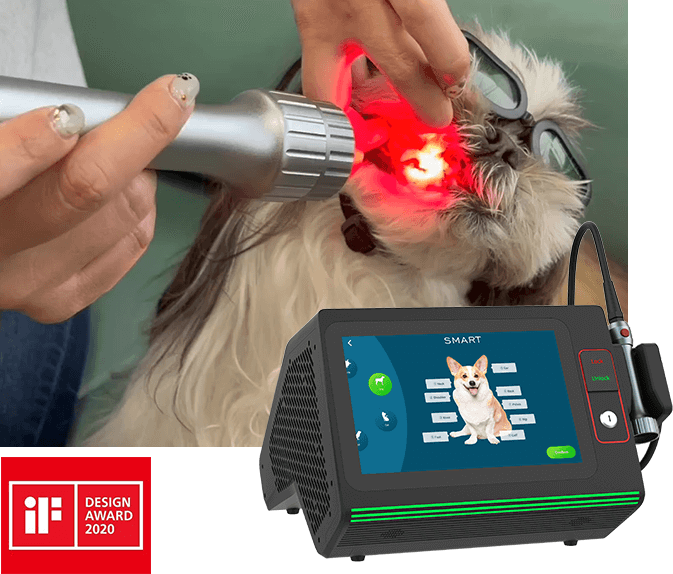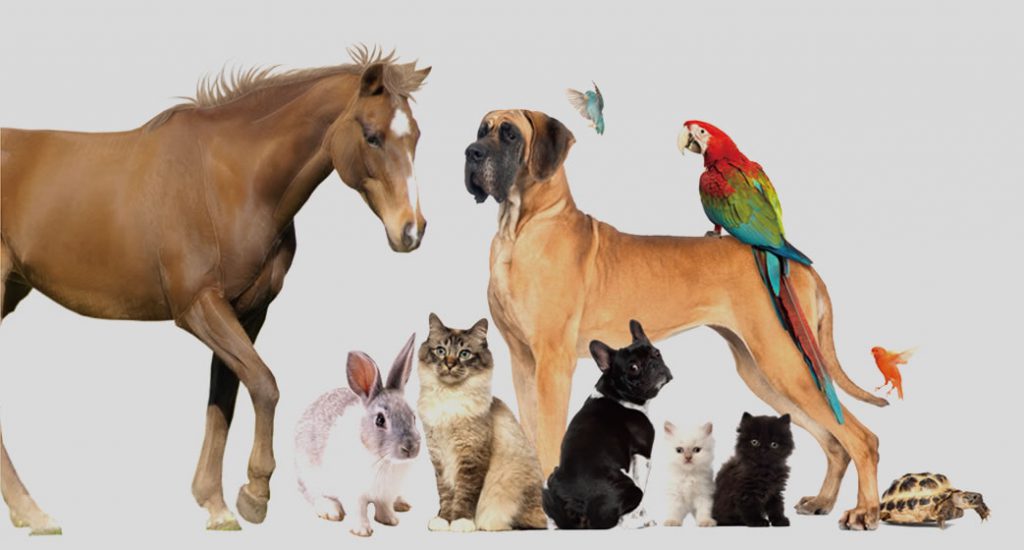Veterinary laser therapy
Class IV therapy laser is a powerful tool that can aid in the treatment of animals suffering from a range of conditions, including pain, arthritis, wounds, muscle injuries, fracture repair, neuropathy, spinal issues, soft tissue injuries, inflammation, and skin conditions. It has demonstrated its ability to reduce the amount of medication required for chronic conditions, alleviate minor aches and pains, and accelerate post-surgical recovery.
Unlike other lasers, Class IV therapy lasers utilize high-powered light waves to trigger photochemical effects within tissues at various depths, which often results in quicker and more effective healing. This treatment can be applied to both acute and chronic conditions across all animal species.

Smooth product lines, modern product appearance, showing the sense of technology and design, won the iF DESIGN AWARD 2020
- Higher Power: 30W/45W/60W
- Four Treatment Modes: CW/Pulse/B/Single Mode
- Dual/Four wavelengths: 635nm/810nm/980nm/1064nm (915nm optional)
- Expert Treatment Protocols
- Intelligent Cloud Management System
- Digital Thermal Imaging
- 20% Faster Treatment Times
- Safe to use: CE certified
Veterinary Laser Therapy
Introducing cutting-edge veterinary laser therapy – a revolutionary approach to pet care. Smart Class IV laser can be used in veterinary therapy, surgery and dentistry. Our machine is the most flexible option for animals undergoing laser therapy! For the general veterinary clinic, professional veterinary center and even the physiotherapy specialist, we all have the right diode laser for you.
Get a Quote, Demo, or More Info Today
Common uses of Class IV therapy lasers by veterinarians:

Benefits of using class IV laser therapy for animals
Class IV laser therapy has emerged as an effective adjunct for veterinarians to aid in the treatment of their patients. The use of these lasers can help animals recover from acute conditions and manage chronic conditions with fewer medications, while also slowing down the progression of many conditions.
Besides, Class IV laser therapy offers the following advantages:
Improved Clinical Outcomes
Patients who undergo surgery or suffer from acute injury/trauma treated with Class IV therapy lasers have a lower risk of infection and quicker healing, leading to enhanced clinical outcomes. This fosters client loyalty and can result in increased word-of-mouth referrals.
Versatility in Treatment
Class IV laser therapy is versatile enough to be used in any room of the clinic, including the waiting room, outside, or even at a patient’s home. This versatility allows veterinarians to treat more patients and conditions with a single unit, making it ideal for house-call practice or ambulatory equine practice.
Establish Credibility with Modern Technology
The use of a Class IV laser establishes credibility for the veterinary practice as modern and innovative, both in acute and management phases. It is a technology that has the perception of being high-tech and cutting-edge.
Efficient Time Management
By using Class IV laser therapy, veterinarians can treat more animals and conditions in less time. This increases productivity and allows doctors to see more patients without requiring additional staff.
The utilization of a Class IV laser is a groundbreaking and thrilling advancement that can assist in treating pets with numerous conditions such as dermatologic, neurologic, musculoskeletal, intra-abdominal, and intra-thoracic ailments. Our experience has shown that this type of laser can be used on animals of any size or shape.
Despite its effectiveness, it is critical for veterinarians to understand the appropriate usage, applications, and safety protocols of a Class IV therapy laser since it is merely another tool.
Veterinarians can use lasers to treat a variety of unique procedures. Some examples include:
- Corneal ulcers: Class IV therapy lasers can treat corneal ulcers by shooting low powers parallel to the eye rather than directly into it.
- Perianal fistulas: Our Class IV laser is an effective tool in managing perianal fistulas, reducing their frequency and severity.
- Intra-abdominal conditions: These conditions refer to various ailments such as cystitis, pancreatitis, acute and chronic kidney disease, and inflammatory bowel disease. Class IV therapy lasers can be a valuable adjunct in resolving feline urethral obstruction or blocked cats.
- Otitis: Otitis is an inflammatory condition of the external ear canal that frequently occurs in dogs and cats. Class IV therapy lasers can help manage this condition.
- Intra-thoracic conditions: Class IV therapy lasers have been shown to treat many conditions within the thoracic cavity, including asthma, idiopathic pulmonary fibrosis, pneumonia, and bronchitis.
- Degenerative myelopathy (DM): This is a disease that affects the spinal cord of dogs. With an aggressive protocol that includes intensive rehab and a high-dosage Class IV laser, DM has the potential to increase a dog’s longevity significantly.
In conclusion, Class IV therapy lasers are highly versatile tools for veterinarians to treat a wide range of conditions, improving not only the quality but also the quantity of animal life.

“As a veterinarian based in United States, I have been using Class 4 laser therapy to treat animals for several years, and its effectiveness has been remarkable. It’s a non-invasive and pain-free treatment that uses high-energy lasers to promote healing and reduce inflammation in pets. It can be used to treat a wide range of conditions, including arthritis, joint pain, wound healing, and post-operative recovery.
In my experience using Class 4 laser therapy, it has been particularly effective in treating chronic conditions such as arthritis. Many older dogs suffer from arthritis and other joint-related issues, and Class 4 laser therapy can provide significant relief from pain and inflammation. My clients have reported improvements in mobility, energy levels, and overall quality of life in their pets after receiving Class 4 laser therapy.”
——Dr. Sophia Lee

[1] Al-Bayti, A. A. (2021). Using short term of high power laser therapy in horse’s tendon injuries. Archives of Razi Institute, 76(5), 1437.
[2] Riegel, R. J., & Godbold Jr, J. C. (Eds.). (2017). Laser therapy in veterinary medicine: photobiomodulation. John Wiley & Sons.
[3] Zielińska, P., Kiełbowicz, Z., & Paczuska, J. (2015). High Intensity Laser Therapy (HILT) in the treatment of orthopedic diseases in horses. Medycyna Weterynaryjna, 71(6), 373-376.
[4] Renwick, S. M., Renwick, A. I., Brodbelt, D. C., Ferguson, J., & Abreu, H. (2018). Influence of class IV laser therapy on the outcomes of tibial plateau leveling osteotomy in dogs. Veterinary Surgery, 47(4), 507-515.
[5] Luna SPL, Schoen A, Trindade PHE, Rocha PBD. Penetration Profiles of a Class IV Therapeutic Laser and a Photobiomodulation Therapy Device in Equine Skin. J Equine Vet Sci. 2020 Feb;85:102846. doi: 10.1016/j.jevs.2019.102846. Epub 2019 Dec 4. PMID: 31952636.
[6] Zielińska P, Soroko-Dubrovina M, Śniegucka K, Dudek K, Čebulj-Kadunc N. Effects of High-Intensity Laser Therapy (HILT) on Skin Surface Temperature and Vein Diameter in Healthy Racehorses with Clipped and Non-Clipped Coat. Animals (Basel). 2023 Jan 6;13(2):216. doi: 10.3390/ani13020216. PMID: 36670756; PMCID: PMC9854543.
[7] Alves JC, Santos A, Jorge P, Carreira LM. A randomized double-blinded controlled trial on the effects of photobiomodulation therapy in dogs with osteoarthritis. Am J Vet Res. 2022 Jun 28;83(8):ajvr.22.03.0036. doi: 10.2460/ajvr.22.03.0036. PMID: 35895799.
THE SCIENCE AND EVIDENCE BACK IT
Assessment of wound area reduction on chronic wounds in dogs with photobiomodulation therapy: A randomized controlled clinical trial. Vet World.
https://pubmed.ncbi.nlm.nih.gov/34566346/
A randomized double-blinded controlled trial on the effects of photobiomodulation therapy in dogs with osteoarthritis.
https://pubmed.ncbi.nlm.nih.gov/35895799/
Management of Primary Injuries of the Medial Collateral Ligament of the Carpus in Two Horses
Medical lasers
Professional CLASS 4 high-power laser therapy machine
Home use
Portable handheld cold laser therapy device
Veterinary use
Laser therapy machine, shockwave physical therapy, widely used in animals